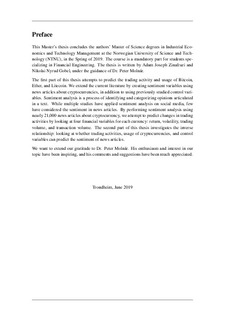| dc.contributor.advisor | Molnár, Peter | |
| dc.contributor.author | Zinafrazi, Adam Joseph" "Gobel, Nikolai Nyrud | |
| dc.date.accessioned | 2019-10-17T14:00:52Z | |
| dc.date.available | 2019-10-17T14:00:52Z | |
| dc.date.issued | 2019 | |
| dc.identifier.uri | http://hdl.handle.net/11250/2622882 | |
| dc.description.abstract | Vi måler sentimentet i nyhetsartikler om Bitcoin, Ether og Litecoin og undersøker om det kan forutse handelsaktivitet og bruk av kryptovaluta. Vi analyserer nesten 21,000 artikler relatert til kryptovaluta lastet ned fra ProQuest sin database fra perioden 11/2013-01/2019. Hver artikkel fikk en sentimentverdi, og verdiene ble aggregert til ukentlige verdier. Ved å bruke tre forskjellige metoder for å beregne sentimentet, finner vi at alle tre metoder kan bidra til å modellere fremtidig avkastning, volatilitet, handelsvolum og transaksjonsvolum for Bitcoin og Ether, men ikke for Litecoin. Videre konkluderer vi med at det ikke er nok å bruke kun én ordbok for å måle sentimentet i en artikkel. Vi har flere funn: 1) antall publiserte artikler forutser volatilitet, 2) antall adresser forutser Bitcoin sin avkastning, 3) volatilitet påvirker handelsvolum negativt for alle kryptovalutaer, 4) høy avkastning fører til høyt transaksjonsvolum for Bitcoin og Ether. Videre undersøker vi den motsatte sammenhengen, hvorvidt handelsaktvitet, bruk av kryptovaluta og andre kontrollvariabler kan bli brukt til å forutse sentimentet i nyhetsartikler. For det første observerer vi at det er store forskjeller mellom sentimentet til de ulike kryptovalutaene. Videre finner vi at følgende variabler kan forutse sentimentet: avkastning, volatilitet, Google-søk, handelsvolum og antall adresser. | |
| dc.description.abstract | We extract sentiment from news articles about Bitcoin, Ether, and Litecoin and analyze whether it can predict the trading activity and usage of these cryptocurrencies. We analyze nearly 21,000 cryptocurrency-related articles obtained from the ProQuest database, spanning the period 11/2013 – 01/2019. Each article receives a sentiment score, and these scores are aggregated for all articles published within a week. Using three different methods to calculate the sentiment score, we find that all three sentiment measures can contribute to predicting the return, volatility, trading volume, and transaction volume of Bitcoin and Ether, but not for Litecoin. We further conclude that it is not sufficient to only use one dictionary to capture the sentiment in an article. We have several additional findings including 1) number of published articles predicts Bitcoin volatility, 2) number of addresses predicts Bitcoin return, 3) volatility negatively impacts trading volume for all cryptocurrencies, and 4) high return leads to high transaction volume for Bitcoin and Ether. Secondly, we then investigate the inverse relationship: looking at whether the trading activity, usage of cryptocurrencies, and control variables can predict the sentiment of news articles. We find that there are significant differences between the sentiment of the cryptocurrencies. In addition, we find multiple factors which can predict the sentiment of news articles, including return, volatility, Google searches, trading volume, and the number of addresses. | |
| dc.language | eng | |
| dc.publisher | NTNU | |
| dc.title | Sentimentet i nyhetsartikler og handelsaktivitet for kryptovaluta | |
| dc.type | Master thesis | |
